In Search of the Niinja (49 page)
Read In Search of the Niinja Online
Authors: Antony Cummins

The essential principle when night attacking a castle is have
Suppa
sneak in and set fires first, then attack from outside taking advantage of the confusion. Without causing any confusion among the enemy, it is hard for you to attack them successfully. For castles that are well defended and where it is hard for shinobi to infiltrate, you will not be able to attack successfully without adopting correct tactics.
Rodanshu
Scroll
The
Rodanshu
translates roughly as ‘A Collection of Ancient Military Wisdom’.
173
Within the circle of ninjutsu researchers, the
Rodanshu
scroll needs little or no introduction; however, it is not a ‘stand alone’ ninja manuscript but rather a collection of military skills which, at certain points, reflects ninja information. Dated to 1846, it claims to be a transmission of skills used by Yamamoto Kansuke and is thought to outline his secret military equipment and strategies. Yamamoto Kansuke was a Sengoku period retainer to the famously successful warlord Takeda Shingen, who was later renowned for using the shinobi and their arts. It appears that the
Rodanshu
is a later and heavily reduced transcription of information that came from a scroll of a similar name orginally transcribed in 1668, and later transcribed by the
Daimyo Toki Masakata
(Sengoku Masakata) in 1865, giving it further credibilty. However, even with this early transcription date it is impossible to know if it was ever connected to the famous Yamamoto himself or if it is even based on the warfare of Shingen at all.
How has this scroll come to be known as a ‘ninja’ scroll? Within the manuscript you can find a small selection of ‘classic ninja tools and skills’ that were recorded in other manuals such as the
Bansenshukai
and which clearly display a certain amount of shinobi information. It is the inclusion of diet pills, collapsible war-boats, the infamous ‘water-shoes’,
174
grapples, and water crossing floats that place this scroll within the realms of ninja technology; however, it only uses the word shinobi once. Strangely, it is the limited use of the word shinobi that gives this manual its authority. This is because if the manual was simply an invention of the nineteenth century (and not a continuation of ancient knowledge), then it would have ‘played up’ its ninja connection. Also, the ninja-like apparatus is mixed in with other ‘samurai’ tools, which to some could be considered mundane, lists of samurai horse-gear and the like make up a large section of the work. Therefore, we can rest assured that this is a genuine article and an accurate transmission of older military skills. Further reasoning for this is that the skills contained within match those of older manuals and are not ‘exciting’; in some cases, they are actually quite drab,
175
which from a historical angle, makes the scroll more credible.
This scroll includes sections dedicated to mounted scouting, or
Monomi
, discussed earlier in this book. The information is a mix of mounted battle and scouting skills which concentrate on equestrian elements but which also include collapsible boats, explosives and fire equipment. This manual is a collection of information for mounted scouts, who at times would have to dismount and possibly split up, allowing a few members to go deeper into enemy territory whilst others stayed with the horses. It describes a mixture of
Monomi
scouting skills and shinobi tools to be used by the same person but at different times, depending on if their task was long range scouting or a deep penetration of enemy lines. There are general battle skills for mounted samurai combat and horsemanship, which can be seen in the contents of the text at the end, such as the two standards or banners and the ‘battle-camp collapsible water bucket’, items found in ‘conventional’ samurai life.
The
Rodanshu
is primarily a ‘picture scroll’ with text information at the end, here the illustrations have been placed in the order they were found and the descriptive text
orginally next to the tools has been numbered with explanatory notes in square brackets that I have added. Throughout the scroll, the term ‘
Kuden
’ is used, which as described before is the concept of passing on information by word of mouth alone and has been translated as ‘secret’ or ‘oral tradition’, however, it must be remembered that
Kuden
in itself does not imply secrecy but means that more information is required.
The
Rodanshu
is one of the classic scrolls referenced by collectors and is a positive step in understanding both mounted scouting and the skills of shinobi.
Shaku | 30cm |
Sun | 3cm |
Bu | 3mm |
Ryo | 15g |
Momme | 3.75g |
Kin | 600g |
Sho | 1.8 litres |
Go | 180ml |
The Tengu Chain Reins
1 The circumference should be 9
Bu
2 The ring should measure 9
Sun
8
Bu
in outer diameter
3 This measurement is over 1
Sun
in diameter
4 3
Sun
3
Bu
5 1
Sun
5
Bu
6 4
Shaku
5
Sun
5
Bu
7 1
Sun
5
Bu
8 Cover the chain with cloth soaked in Tung oil and bind and sew over it all in leather.
9 Use a rope made from the
Ramie
176
plant as the core of this ring and bind it all in leather and lacquer it.
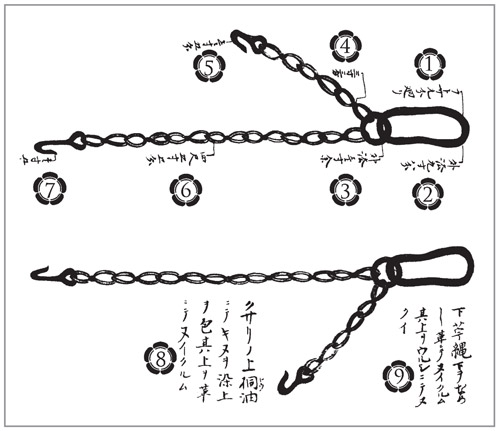
‘The Reins of a Rock Pulling Against a Stone’
1 Make this rope of the
Ramie
plant and cover with leather
2 Tie the
Ramie
rope with firm knots, like this.
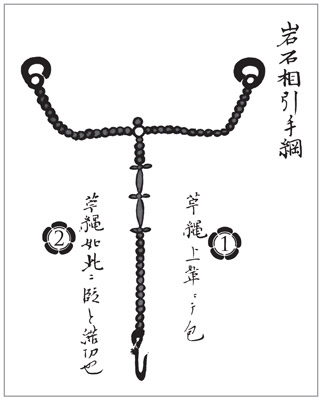
[The use of this item is unknown, however it appears to be alongside a pair of horse reins and itself is titled as a form of rein. Therefore, on the small amount of evidence available it is possible that this is a form of martingale, a section of tack that connects the horse’s head to a strap along its chest, preventing the horse from raising its head up too far.]
‘Short Rods [For Prompting a Horse]’
A one
Sun
177
rod or whip
The same as the last tool.
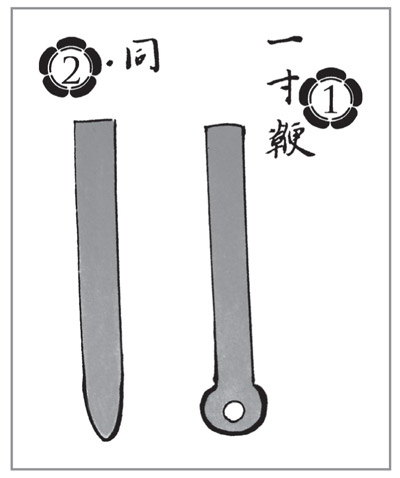
‘Lacquered Waist Attachment for a Sword Scabbard’
1 Attaching hook
3 Tanned leather with lacquer
4 Tie
Ramie
rope with a line of firm knots, like this [the ball configuration]
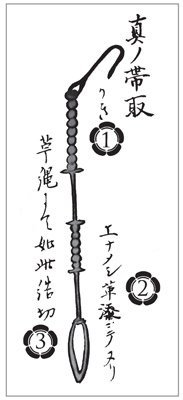
[This is an attachment from the waist to the scabbard of your sword. What is unknown is if this was the construction used in day-to day-life or if this was for equestrian purposes only.]
‘Standard Iron’
178
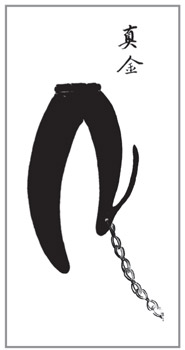
‘Dream-like Iron’
[The military war manual found at the end of the
Bansenshukai
ninja scroll talks of ‘hinges’ used to hold spears, and comparing these with the ‘Spear Rest’ which appears a little further down the scroll, then it would seem that these are also those ‘Spear Rests’, most likely a platform for a lance-type weapon. The translation of ‘real and dream-like iron’ is a literal translation and is based purely upon the meaning of the ideograms, if the word is based in a phonetic understanding – which it originally may have been – then its meaning has been lost.
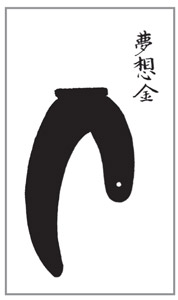
‘A four
Sun
Horse-bit’
1 Also known as a
Mukotsume
